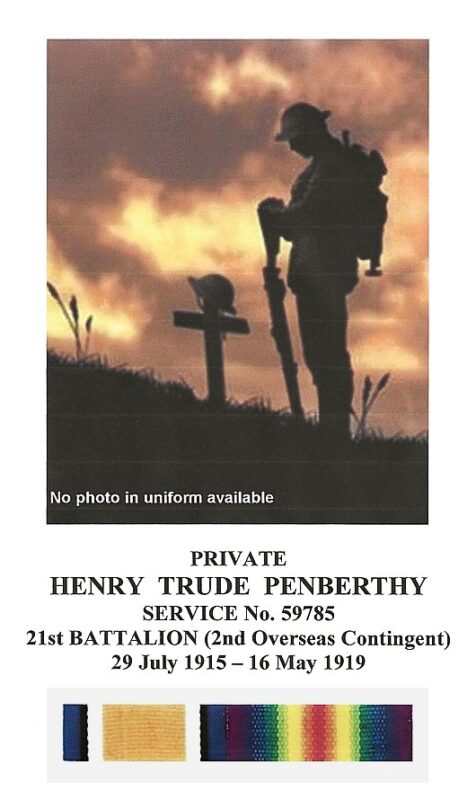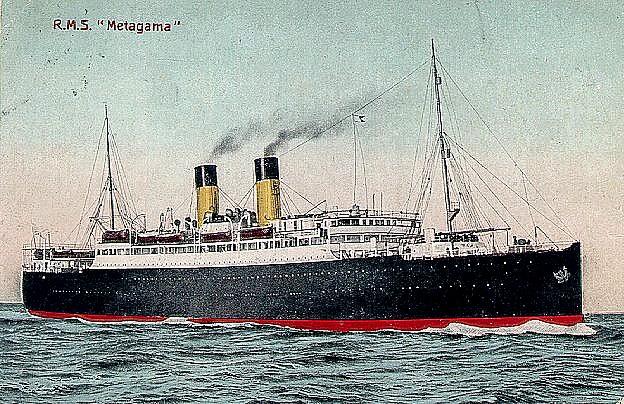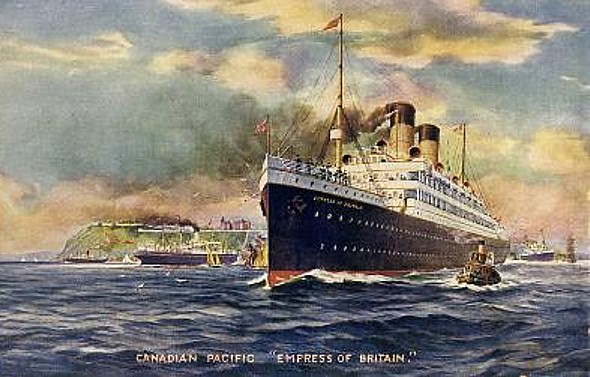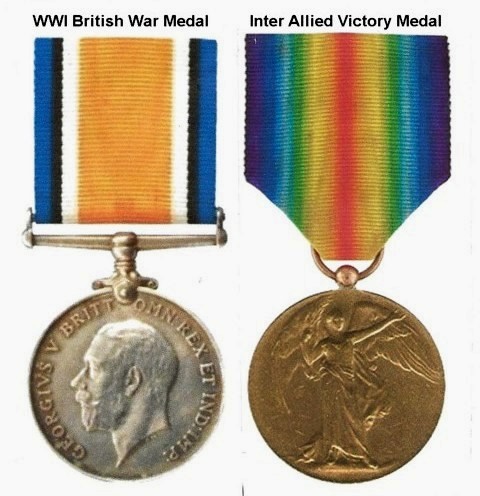
MILITARY HISTORY
PRIVATE HENRY TRUDE PENBERTHY – No. 59785– Active Service (World War I)
On November 11th, 1914, Henry “Harry” Trude Penberthy completed the Attestation Paper for the Canadian Active Service Force (CASF) at Kingston Ontario. He was 34 years old when, as an unmarried man, he enlisted for the duration of the War. Henry was born in Exeter England and gave his birthdate as July 31, 1880. He listed his present address as Lakefield, Ontario. His next of kin was listed as William Trude Penberthy, Devonshire, England, Henry indicated that he had no previous Military experience and he had not served in an Active Formation or Unit of The Canadian Army.
Henry indicated he had previously worked as a farmer. He was described as standing 5 feet 7 ½ inches with a dark complexion and brown eyes and black hair. He was trained in Kingston Ontario with the 21st Battalion (2nd Overseas contingent) and sent overseas on May 20th, 1915. He sailed from Montreal aboard the SS Metagama.

21st Battalion History
On October 19, 1914, authority was granted to organize the 21st Infantry Battalion CEF. Lieut/Col (later Brig-Gen) William St Pierre Hughes, a member of the distinguished military family, and Commanding Officer of the PWOR was appointed to command. It was to be absorbed into the second Canadian contingent for overseas service. Personnel was to be from Eastern Ontario, including Ottawa, Kingston, Belleville, Picton, Cobourg, Brockville, Lanark, Perth, Smith’s Falls, Carleton Place, Almont, Arnprior, Renfrew, Pembroke, Lindsay, Port Hope, Bowmanville, Trenton, Prescott, Peterborough, and Cornwall. Many officers and men from the PWOR joined their Commanding Officer in the new battalion.
The training was carried out through the winter and into the spring of 1915. On May 5, 1915 the Battalion left Kingston for Montreal by train. On arrival in Montreal the following day, they proceeded directly to the docks where they embarked on the Troopship Metagama.
They disembarked in Devonport England and proceeded to the West Sandling Camp, near Hythe, Kent. Here they continued their training and toughening up process. They sailed for France from Folkestone on September 15, 1915 aboard the steamer St. Seiriol.

The battalion arrived in Boulogne about nine o’clock, and it had been the first to cross the channel in daylight. They were cheered on their way by French soldiers and civilians. At a rest camp just outside the city, all were glad to throw off their heavy packs and enjoy a well earned rest.
The battalion rested during the afternoon and at eight o’clock that night, fell in and marched to the station where they entrained for St. Omer. Cattle trucks had been fitted up for the transportation of troops and in them, the men piled, forty to a car. At St. Omer, at about 2:00 a.m., the battalion was joined by the Transport and Details sections under Major Bennett who had come from Havre; then commenced the long march to the trenches.
It was surely a test of physical fitness and determination for these men and for those who have carried a sixty-pound pack, rifle, equipment, ammunition, water bottle, haversack, smoke helmet and the various other parts of a soldier’s equipment.
Feet were blistered and sore, and perspiration almost blinded them, but their spirits never flagged. They were on their way to the trenches. After months of training, they were at least nearing the goal of their ambition. They were happy, and though it sometimes cost an effort, they joked and sang as they covered the weary miles.
At night they halted in the fields and the barns along the route. The months of hard training in Canada and England had not been in vain was shown on this march, the first of the many which the 21st Battalion was to make in France and Belgium.
Departing St. Omer, the battalion marched all night, making its first halt at Renesure at 7.00 a.m. Cookers, the gift of patriotic friends of the 21st Battalion, accompanied the unit and were never more appreciated than when breakfast was served from them in a large field along the way. After a rest of several hours, they fell in at 11.00 a.m. and continued, reaching Eecke, at 6.00 p.m.
The following day, the battalion was inspected by Major-General Alderson, General Officer Commanding Canadians in France. General Alderson addressed a few remarks to the battalion in which he complimented them on their fine appearance, spoke of the high standard which had been maintained by the Canadians and expressed his confidence in both officers and men of the battalion.
A rumour had spread that the 21st Battalion would not go into the trenches for a week of two, but this was discredited by General Alderson, who informed the battalion they would go into the firing line immediately. This news was received with cheers and was the sole topic of conversation in billets that night.
On September 18th Lieutenant-Colonel Hughes, accompanied by Major E.W. Jones, Major T.F. Elmitt, Major S.W. Gray, Captain F. Scott, Captain A.H. Stroud, Lieutenant F.D. Raymond and Lieutenant H.W. Cooper as well as Battalion Sergeant-Major Gilbert and several NCOs left billets at 6.00 a.m. and proceeded to the trenches which the battalion was to take over. The battalion under command of Major C.C. Bennett started early in the morning on the last lap of the journey to the trenches.
As part of the 4th Canadian Infantry Brigade, the 21st Battalion served with distinction until the end of the war. They earned several Battle Honours with including Vimy Ridge which to emblazon their Colours. Sadly, many heroes paid the supreme sacrifice and remain in Flanders Fields. 1,013 men left Kingston in May of 1915 with the Battalion, but when they marched into Germany as part of the occupying force at war’s end, only 103 of those originals remained.
On May 24, 1919, the 21st Battalion was demobilized in Kingston and the men discharged from the CEF. .A dinner was held that evening in the Armouries for those men before they departed for their homes across Ontario. Private Penberthy embarked for France on September 14, 1915.
Private Penberthy suffered from several outbreaks of Onychia in 1916. He suffered abrasions to his right eye and deafness on May 22, 1917. He taken to hospital but was discharged on May 26th, 1917. He suffered from appendicitis on August 12th, 1918 and was taken to a university hospital in South Hampton, England. He was discharged on January 22, 1919. Private Penberthy sailed home to Canada on the Empress of Britain on 23rd of March 1919.

Private Penberthy was discharged on April 1, 1919 in Kingston Ontario. He had served 4 years 3 months 1 year in England/Canada and 3 years 3 months in Europe. He was eligible for the Volunteer Service medal, British War Medal (England and France). Private Penberthy died in Cobourg, Ontario on February 25th, 1975.
An excerpt from an article in McLean’s magazine by Barbara Amiel, September 1996:
The military is the single calling in the world with job specifications that include a commitment to die for your nation. What could be more honorable?

PERSONAL HISTORY
PRIVATE HENRY “HARRY” TRUDE PENBERTHY
Henry “Harry” Trude Penberthy was born in England on July 31, 1880, the only son of Sara Solam Trude and Richard Penberthy. Harry received his education in England and later worked as a farmhand. In May 1910, Harry and his younger sister Dora immigrated to Canada on SS Lake Manitoba landing in Quebec City with the hopes of getting to Peterborough and finding work as a farmhand and domestic. In 1911 Harry and his sister Dora were boarders at the home of Chassie (nee Strickland) & Edmund Tate living in Douro Township.
In November 1914, Harry decided to go to Kingston and enlist to serve his King and Country. Private Penberthy gave more than four years to military service before returning home to Lakefield.
Harry married Henrietta “Etta” Waldon, daughter of Henrietta Trude and Frederick Waldon and they made their home in Lakefield. Henry was a 25-year employee of the Lakefield College School.
The Penberthy’s were members of St. John the Baptist Anglican Church. Harry was a member of the Lakefield Curling Club and was made an Honorary Member of the Royal Canadian Legion Branch #77. Henrietta passed away on December 21, 1956 and Harry died on February 25, 1975 – age 94 years; both are buried in Lakefield Cemetery.